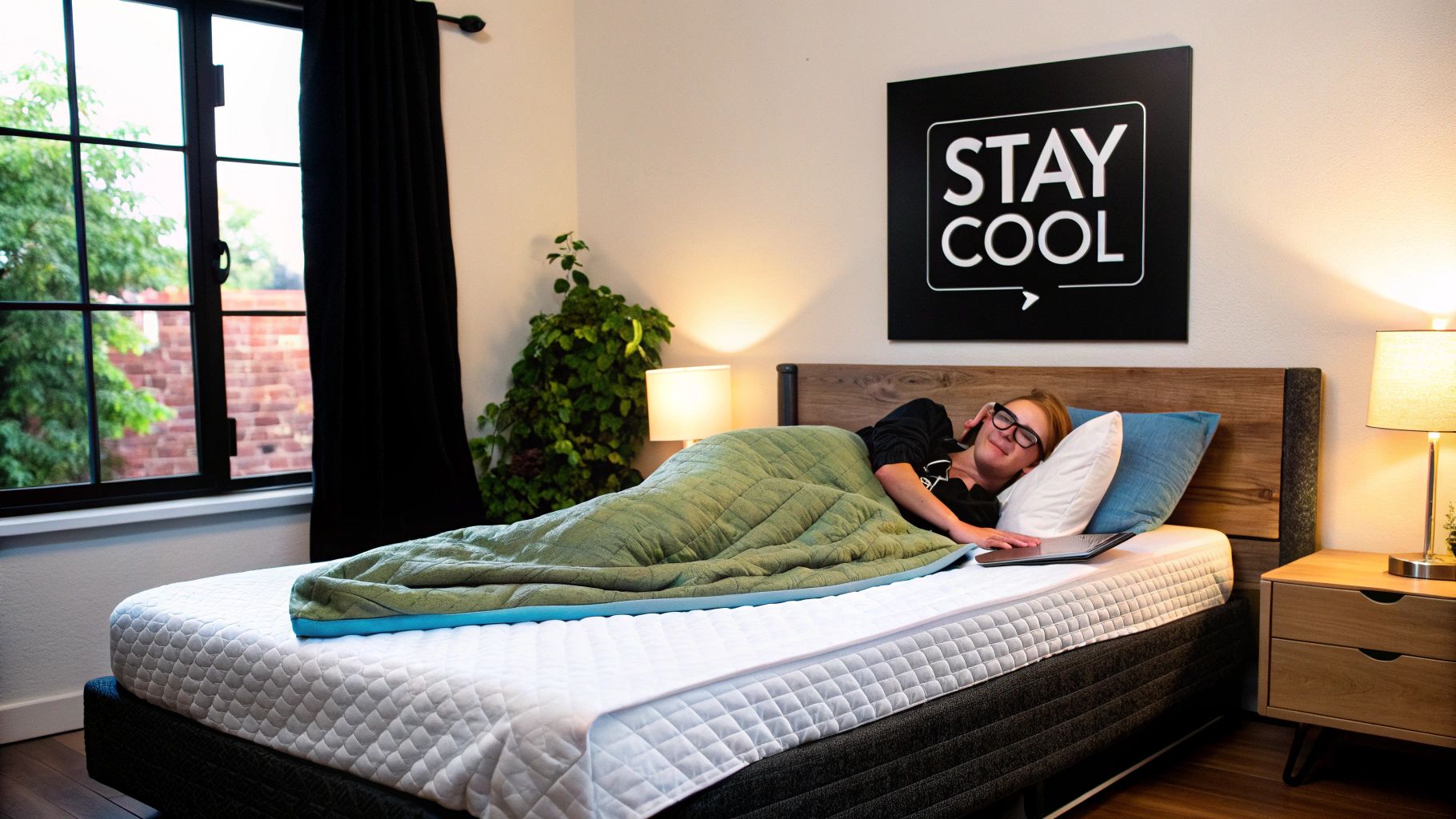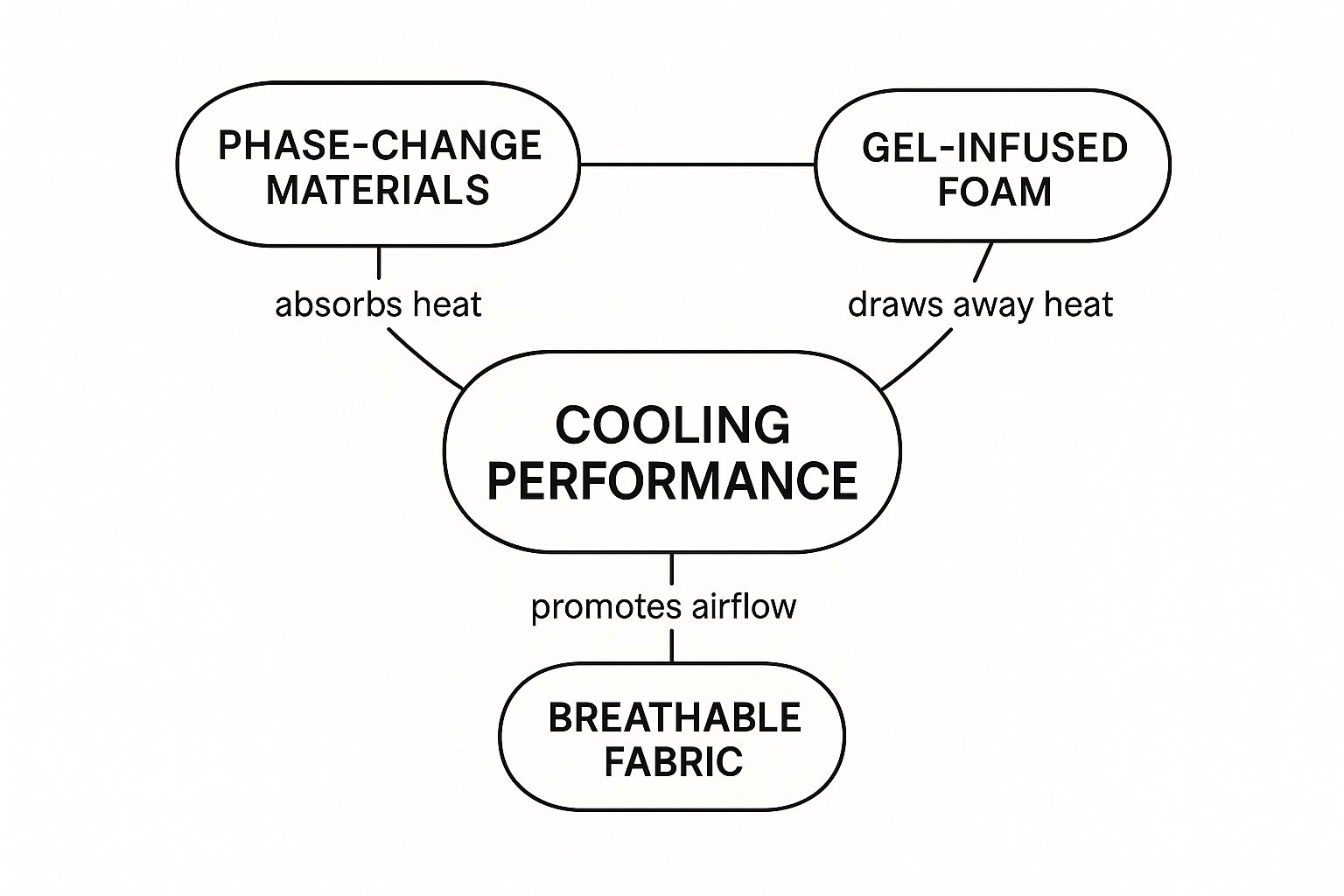Staring at the ceiling at 2 AM, tangled in sheets and feeling like a human radiator, is a special kind of frustration. What if the solution was simpler than cranking up the air-con? It could be a cooling mattress cover—think of it as getting the cool side of the pillow, but for your entire body, all night long.
This guide will give you the essential, no-fluff information you need to choose the right cover and finally end those sweaty, sleepless nights.
Tired of Waking Up Hot and Sweaty?
That nightly battle for a cool spot on the bed wrecks your sleep, leaving you drained and foggy the next day. A cooling mattress cover is engineered to combat this by actively drawing heat and moisture away from your body. This helps maintain a stable, comfortable temperature for deep, uninterrupted rest.

It’s a common problem. For instance, someone with a memory foam mattress loves the pressure relief, but finds they wake up overheated halfway through the night. Adding a cooling cover can solve this without needing to buy a whole new mattress.
This need for better rest is a growing concern. According to research, the global market for mattress pads and protectors is booming, largely driven by consumer focus on sleep hygiene drives the mattress accessories market. People are actively seeking solutions that work.
Beyond comfort, a cooling layer can be a smart move for your wallet. It can reduce your reliance on overnight air conditioning, aligning with strategies to save energy at home.
How Does a Cooling Mattress Cover Work?
So, how do these covers stop you from overheating? It's not magic; it's clever material science. A cooling mattress cover uses specific technologies to manage heat and keep you comfortable all night.
One simple way is through conduction. Think of how a cool marble countertop feels on a warm day—it pulls warmth from your hand. Some covers use materials that do the same thing for your whole body.
Other designs focus on breathability and moisture-wicking. They use fabrics that allow air to circulate freely and pull sweat away from your skin, much like high-tech activewear. This prevents that clammy, sticky feeling.
A key innovation to look for is Phase-Change Materials (PCMs). These are smart fabrics that absorb your excess body heat. If you start to get chilly, they can even release that heat back to you, constantly working to keep your sleep temperature just right.
Choosing Your Ideal Cooling Material
The material is the most important factor when picking a cooling mattress cover. It determines how it feels, how well it cools, and how you care for it. Your choice comes down to natural fibres like cotton and bamboo, or advanced synthetic options.
Natural vs. Synthetic Fibres
Natural fabrics like cotton or bamboo are fantastic for their breathability. If you just need gentle airflow to prevent heat build-up, these are a brilliant choice. They provide that classic, crisp bedding feel. For a deeper dive, see our comparison of cotton vs. bamboo-cotton sheets.
Synthetics and infused foams are engineered for a more active cooling effect. They don't just let air circulate; they are designed to physically pull heat away from you. This is the best option for those who feel chronically hot at night.

So, what’s the right call? If you're a "sometimes hot" sleeper, natural breathability might be enough. If you're a "human furnace," you'll want the heavy-duty help of engineered cooling.
To help you decide, here’s a quick comparison of common cooling materials.
Cooling Material Quick Guide
| Material Type | Cooling Mechanism | Best For | Feel & Texture |
|---|---|---|---|
| Cotton | Breathability: Allows air to circulate, preventing heat build-up. | Those who prefer natural fibres and a classic, crisp feel. | Crisp and soft. |
| Bamboo | Moisture-wicking & Breathable: Pulls moisture away from skin and is very airy. | Hot sleepers who sweat and those with sensitive skin. | Silky-smooth and soft. |
| Gel-Infused Foam | Conduction: Gel microbeads absorb and pull heat away from the body. | Sleepers who want pressure relief and a noticeable cooling feel. | Contouring and plush. |
| Phase-Change Materials (PCM) | Heat Absorption & Release: Smart technology absorbs and releases heat to regulate temperature. | Serious hot sleepers who experience temperature fluctuations. | Varies; often feels slick or cool on contact. |
Unlock the Health Benefits of Cooler Sleep
A cooler night's sleep is about much more than just comfort; it's fundamental to good health. Your body's core temperature needs to drop slightly to initiate and maintain deep sleep.
Research shows that an optimal sleep environment is crucial for achieving the deep, restorative stages of sleep. When you're too hot, your body struggles to reach this state, leading to fragmented rest.
A cooling mattress cover helps your body maintain that ideal, lower temperature. This is why it's so important to understand why breathable fabrics improve sleep quality. The result is waking up feeling not just rested, but truly rejuvenated.
How to Care For Your Cooling Mattress Cover
You've invested in better sleep, so let's make it last. Proper care is key to protecting your cooling mattress cover and its technology. While most are machine washable, always check the care label first.
Simple Washing and Drying Tips
Actionable Insight: Always use a gentle, cold water cycle. High heat can damage or destroy the heat-sensitive fibres or gel infusions that make your cover work.
The golden rule? Avoid the high-heat dryer setting. Tumble dry on the lowest setting possible, or even better, let it air dry. This preserves the cooling properties.
Crucial Tip: Never use fabric softeners or bleach. These products can clog the pores in the fabric, stopping it from wicking moisture and breathing effectively. For more tips on specialty bedding care, see our guide on how to care for bamboo sheets.
Your Checklist for Making the Right Choice
Ready to choose? The secret is matching the cover to your specific needs, not just picking the most expensive one. Use this quick checklist to make a smart investment.
- How Hot Do You Sleep? Be honest. Are you a true ‘human furnace’ needing active cooling, or do you just need more breathability?
- What Is Your Mattress Type? If you have a memory foam mattress that traps heat, a cover with conductive cooling (like gel-foam) is a perfect partner.
- What Feel Do You Prefer? Do you like the silky feel of bamboo, the crispness of cotton, or the plush contouring of foam?
- Check the Fit: Ensure the cover has a deep enough pocket to fit your mattress securely. A "skirt" or "fitted sheet" style is usually best.
Your Questions, Answered
Let's tackle some common questions about choosing a cooling mattress cover.
Will it make me cold in winter?
No. A good cooling mattress cover provides temperature regulation, not just one-way cooling. Think of it as a thermostat for your bed. It helps excess heat escape when you're hot, but it won't make you cold. You'll still be cosy in winter.
Is this different from a mattress protector?
Yes. A mattress protector’s main job is defence—shielding your mattress from spills and allergens. A cooling mattress cover’s main job is comfort through temperature management. Many modern covers, however, do both.
Can I use one on my memory foam mattress?
Absolutely! It's a perfect match. Memory foam is known for trapping heat. Adding a cooling cover lets you enjoy the pressure-relieving benefits of foam without the overheating downside.
Time to Stop Sweating and Start Sleeping
Choosing the right cooling mattress cover is a simple, effective step towards ending restless nights. By focusing on the material and technology that best suits your needs, you can unlock deeper, more restorative sleep.
Ready to transform your bed into a cool oasis?

